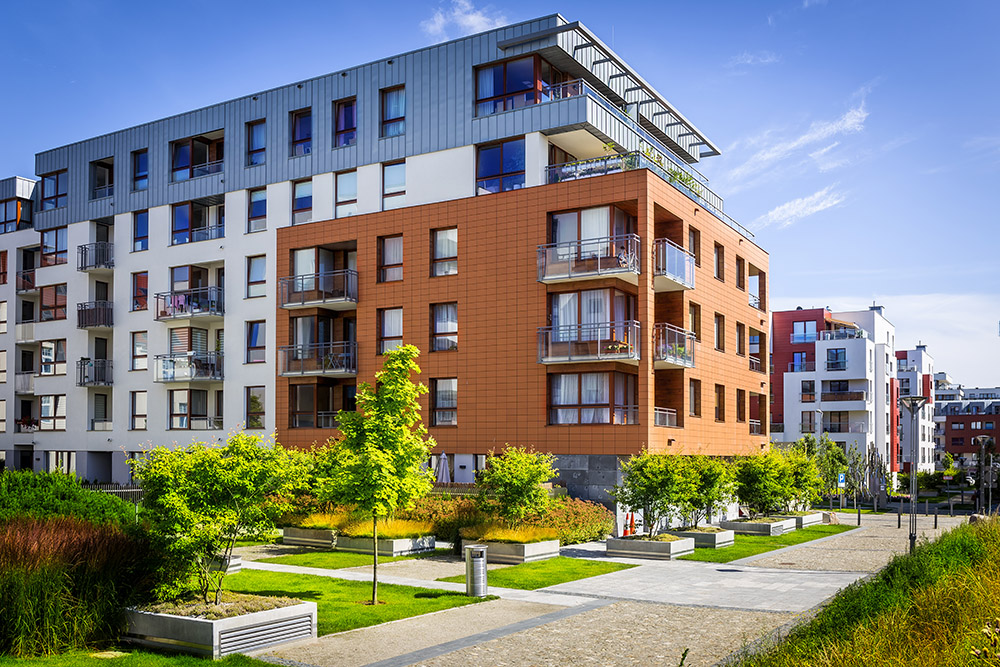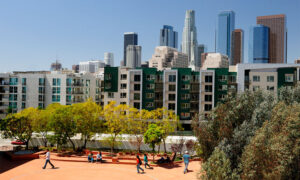If you think every new apartment looks the same these days, you aren’t alone. Boxy mid-rise structures have cropped up in cities across the country, drawing the ire of neighbors and some architecture critics who find the buildings bland or downright ugly.
Why do so many of these “podium” apartments – built in cities from Nashville to Los Angeles and which typically include retail stores or parking on the first floor – look the same? And does that even matter during a housing crisis when more units are needed?
To answer these questions, we spoke with Liz Falletta, an architect, professor at the USC Sol Price School of Public Policy and author of By-Right, By-Design, an interdisciplinary study of significant Los Angeles housing design precedents and their related development types. She also discussed housing affordability ahead of her appearance on the panel, “Confronting L.A.’s Housing Crisis: Lessons from Our Residential Legacy,” during the Los Angeles Times Festival of Books at USC.

Are housing developments becoming more homogenous?
Podium apartment buildings can be very similar and I think there are many reasons for that. Are they more homogenous than other housing types built in the past? I don’t think so. Their design might be more objectionable, perhaps, but Sears used to sell kit houses across the nation, for example, which you can see in many neighborhoods in Los Angeles. So, I think the homogeneity we are seeing today is similar to what we’ve seen in the past, but the forces driving it are probably somewhat different.
What is driving this trend?
One big driver is zoning. The amount of space zoned for multifamily housing in our cities is small yet concentrated, so you have a density of podium buildings being built in the same locations. Another factor is the building code. Most cities in the U.S. use the same building code, one that has evolved to allow this kind of stick-built construction over a concrete podium, which is a lot cheaper than other construction types, even though there are some drawbacks to it.
My gut says institutional capital plays a role too. It’s national capital, not local capital, that’s financing these buildings, and it’s large-scale developers who are building in multiple cities. These buildings are often built to sell to large real estate investment trusts, so when anything’s a commodity like that, making it similar across examples is desirable.
Does it matter that these buildings may make cities look less unique?
I really think, given our housing crisis, let’s just build. The longer we spend arguing about what it looks like, the less housing gets built. I think we need to come to terms with this one way or the other because otherwise we’re doing the younger generations – who are experiencing this housing crisis more acutely – a big disservice.
You’re going to be speaking at the L.A Times Festival of Books about confronting the housing crisis. What needs to happen, in your opinion?
The professionals involved in housing production need to be able to speak one another’s language and talk meaningfully across professions if we are going to build more and better housing.

Master of Real Estate Development
From Vision to Reality
Master the art of real estate development and elevate your career.
Find Out MoreThere is a lot of policy experimentation in housing right now which I think is a great thing. Because we are not going to fix the crisis in one fell swoop with a single strategy. We need 50 different strategies all working towards the goal of more housing production.
Do these podium developments help rein in housing costs or build housing faster?
Yes and no. Everyone in the development process, from lenders to contractors to communities, are very familiar with the type, which should make them easier and faster to build. But, ironically, by trying to be maximally unobjectionable by design so that projects can be approved, it results in objection to them because they’re all the same. The sameness is an attempt to reduce costs and build faster, but it’s not being received that way.
Have there been aesthetic objections to housing developments before?
In the late 1950s, early 1960s, you simultaneously had a lot of people moving into retirement, but also a lot of younger people coming of age who were delaying marriage or going to college, two demographics for which a single-family home was not always suitable. So there was an increased demand for apartment living, and that’s really when the dingbat came of age. It was maligned by everyone, initially, but ultimately dingbats provided good housing at an affordable price to many people for whom renting was desirable. And now they are beloved, by some anyway, for their mid-century design.
Do you think we will learn to love the podium apartment?
People are going to live their lives here and significant things will happen in them, so they’re going to weave their way into people’s experience and memory. People are going to forget that they were generic because that’s not going to be the most important thing anymore, right? Because they’ll be embedded into the history of people and place.
Liz Falletta will join fellow panelists Ken Bernstein, Todd Gish and Frances Anderton to discuss “Confronting L.A.’s Housing Crisis: Lessons from our Residential Legacy,” during the Los Angeles Times Festival of Books at USC at 12pm on April 23 at Wallis Annenberg Hall.





